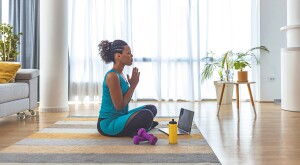Crunches may get all the love, but the plank is another practice you should add to your ab-sculpting regimen. Plank pose is exactly what it sounds like: holding your body in a straight line like a wooden plank. It may not seem like it’ll do much, but this exercise can work wonders, whether you’re trying to tighten your tummy or go for the ultimate goal of washboard abs.
Here’s why you should consider adding planks to your life:
• Planks help your stomach look slimmer. Now, we won’t lie: You’re not going to get washboard abs just by doing planks (or crunches). For that to happen, your nutrition must be on point and you need to do a mix of cardio and other strength training exercises, too. However, “with proper form, planks activate core muscles including the six-pack muscles and the ‘corset’ muscle that cinches the waist,” says Ivory Howard, M.P.H., a certified yoga and Pilates instructor based in Washington, D.C. In fact, planks work every muscle in your core: your front abdominal muscles, the sides of your waist, the muscles in your lower back and hips, the muscles in your pelvic floor, your diaphragm and your glutes. “You want to strengthen all of those in order to pull in your stomach and achieve that flat look,” says Howard.
• Planks work both upper and lower body. Though planks are mostly a core exercise, they can also help strengthen the arms and shoulders, especially if you do different variations, Howard says. Push-ups, walking planks or plank rows can all help tone the upper body. And activating your glutes, quads and hamstrings while in a regular plank, or doing a reverse plank or a plank with a shoulder tap, can give your lower body a good pump.
• Planks improve your posture. Poor posture isn’t doing your appearance any favors. When you’re not in what’s known as neutral spine (maintaining the natural curves of the spine), oftentimes that means you have an arched back and you’re pushing your stomach forward, Howard says. This can give that dreaded potbelly look. “Plank exercises help you to maintain a neutral spine, or proper alignment, preventing the abdomen from protruding,” says Howard. So, even if you haven’t lost a lick of weight, your stomach may look flatter (and you may look taller).
• Core exercises make daily activities easier. Think movements like reaching to get something from a top shelf, bending to pick something up off the floor and twisting to check your blind spot while driving. A strong core can also help improve balance and stability and reduce your risk of (or improve) lower back pain.
• Planks help prevent exercise-related injuries. Having strong core muscles helps you better brace yourself when performing other exercises like dead lifts and squats. That means you’ll be at less risk of injuring yourself.
• Planks are convenient. You can do these body-weight moves anywhere, anytime. They take only minutes. And no equipment is necessary (though you may want to do planks on a carpeted area or mat for cushioning).
• There are many variations. Planks can be adapted to fit any fitness level, whether you’re a newbie, a plank queen or somewhere in between.
Perfect your plank
Try to do planks at least two to four times a week. Depending on your abilities, hold the position for 10 to 30 seconds, then lower your body to rest. That counts as one set. Repeat. Aim to do two to three sets of planks.
Slowly work your way up to planking for a minute or two by adding five- to 10-second increments.
Beginner: Modified plank
How to: Lie facedown on the floor and lift yourself so that your weight is resting on your forearms and knees. Make sure your elbows are directly under your shoulders. Your head, neck and back should form a straight line. Tighten your ab and glute muscles and hold the position.
Intermediate: Forearm plank
How to: Lie facedown with your elbows directly under your shoulders and legs extended, feet together. Tighten your abs and glutes. Then raise your body so it forms a straight line, with your weight resting on your forearms and toes. Look at the floor and breathe normally. Hold the position. Make sure your butt doesn’t rise in the air or sag toward the floor.
Advanced: High plank
How to: Start at the top of the push-up position with your elbows directly under your shoulders. Engage your abs and glutes. Hold while maintaining a straight line from head to toe. Again, keep your gaze on the floor, breathe normally and don’t let your butt sag or rise.
Once you’ve mastered these planks (or if you need more of a challenge), try raising one leg for a couple of seconds, and then repeat with the other leg. You can also rock your body forward and backward while holding plank pose, do side planks, walking planks, planks with shoulder taps, plank jacks, reverse planks and much more. All will help whittle your middle and give your entire body a good workout.









